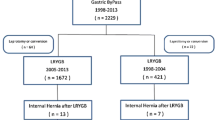Abstract
Background and Aims
Bowel obstruction due to internal hernia (IH) is a well-known late complication of a laparoscopic roux-en-y gastric bypass (LRYGBP). The objective of this study is to evaluate if closure of the mesenteric defect and Petersen’s space will decrease the rate of internal hernias compared to only closure of the mesenteric defect.
Methods
A single-center retrospective descriptive study was performed. All patients with LRYGBP from 2011 till April 2017 were included. An antecolic technique was used with closure of the mesenteric defect with a non-absorbable running suture between 2011 and October 2013 (group A), and from November 2013, we added closure of the Petersen defect (group B).
Results
From a total of 3124 patients, 116 patients (3.71%) had an exploratory laparoscopy due to suspicion of bowel obstruction, but in only 67 (2.14%) patients, an IH was found. Preoperative CT predicted the diagnosis in only 73%. In group A, including 1586 patients, 53 (3.34%) were diagnosed with an internal hernia: 39 at Petersen’s space and 14 at the mesenteric defect. The mean time interval was 24.2 months and the mean BMI 25.7 kg/m2. After routine closure of the Petersen defect in 1538 patients in group B, an internal hernia during laparoscopy was found in 14 (0.91%) patients after a mean period of 13.5 months: 11 at Petersen’s space and 3 at the mesenteric defect. In two subgroups (C and D) with an equal follow-up time (24–42 m), the incidence of 1.15% (8/699) was halved in the closure group of both defects compared to the incidence of 2.58% (23/893) in the group with only closure of the mesenteric defect.
Conclusions
After descriptive analysis, these results can provide strong recommendation of closure of the mesenteric defect and Petersen’s space, as we notice a tendency to lower incidence of internal hernias.





Similar content being viewed by others
References
Iannelli A, Buratti MS, Novellas S, et al. Internal hernia as a complication of laparoscopic roux-en-Y gastric bypass. Obes Surg. 2007;17(10):1283–6.
Marmuse JP, Parenti LR. Gastric bypass. Principles, complications, and results. J Visc Surg. 2010;147(5 Suppl):e31–7.
Stenberg E, Szabo E, Agren G, et al. Closure of mesenteric defects in laparoscopic gastric bypass: a multicentre, randomised, parallel, open-label trial. Lancet. 2016;387(10026):1397–404.
Schneider C, Cobb W, Scott J, et al. Rapid excess weight loss following laparoscopic gastric bypass leads to increased risk of internal hernia. Surg Endosc. 2011;25(5):1594–8.
Dilauro M, McInnes MD, Schieda N, et al. Internal hernia after laparoscopic roux-en-Y gastric bypass: optimal CT signs for diagnosis and clinical decision making. Radiology. 2017;282(3):752–60.
Iannelli A, Facchiano E, Gugenheim J. Internal hernia after laparoscopic roux-en-Y gastric bypass for morbid obesity. Obes Surg. 2006;16(10):1265–71.
Kristensen SD, Jess P, Floyd AK, et al. Internal herniation after laparoscopic antecolic roux-en-Y gastric bypass: a nationwide Danish study based on the Danish National Patient Register. Surg Obes Relat Dis. 2016;12(2):297–303.
Chowbey P, Baijal M, Kantharia NS, et al. Mesenteric defect closure decreases the incidence of internal hernias following laparoscopic roux-en-Y gastric bypass: a retrospective cohort study. Obes Surg. 2016;26(9):2029–34.
Lockhart ME, Tessler FN, Canon CL, et al. Internal hernia after gastric bypass: sensitivity and specificity of seven CT signs with surgical correlation and controls. AJR Am J Roentgenol. 2007;188(3):745–50.
Altieri MS, Pryor AD, Telem DA, et al. Algorithmic approach to utilization of CT scans for detection of internal hernia in the gastric bypass patient. Surg Obes Relat Dis. 2015;11(6):1207–11.
Aghajani E, Jacobsen HJ, Nergaard BJ, et al. Internal hernia after gastric bypass: a new and simplified technique for laparoscopic primary closure of the mesenteric defects. J Gastrointest Surg. 2012;16(3):641–5.
Jacobsen H, Dalenback J, Ekelund M, et al. Tensile strength after closure of mesenteric gaps in laparoscopic gastric bypass: three techniques tested in a porcine model. Obes Surg. 2013;23(3):320–4.
Kristensen SD, Floyd AK, Naver L, et al. Does the closure of mesenteric defects during laparoscopic gastric bypass surgery cause complications? Surg Obes Relat Dis. 2015;11(2):459–64.
Author information
Authors and Affiliations
Corresponding author
Ethics declarations
Conflict of Interest
The authors declare that they have no conflicts of interest.
Ethical Approval Statement
For this type of study, formal consent is not required.
Informed Consent Statement
Does not apply.
Rights and permissions
About this article
Cite this article
Blockhuys, M., Gypen, B., Heyman, S. et al. Internal Hernia After Laparoscopic Gastric Bypass: Effect of Closure of the Petersen Defect - Single-Center Study. OBES SURG 29, 70–75 (2019). https://doi.org/10.1007/s11695-018-3472-9
Published:
Issue Date:
DOI: https://doi.org/10.1007/s11695-018-3472-9




